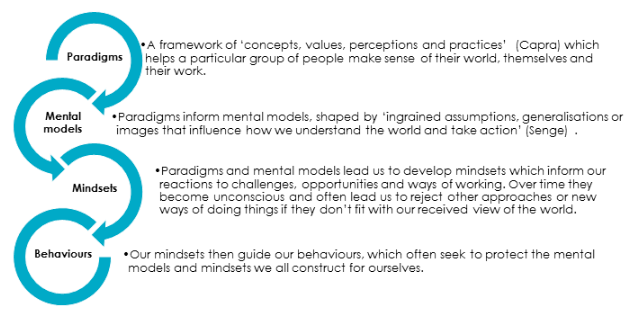
Photo by Suad Kamardeen on Unsplash
Speaking at the ICRS meeting on Partnerships for impact, I shared insights from our research and experience on four calls to action for purposeful partnering.
- Break and remake the mental models in our organisations to deliver purposeful partnerships, not just rhetoric.
- Invest in and measure the impact of partnerships, not just programmes and projects. They are needed for long-term transformation.
- Diagnose, and actively manage, power in partnerships.
- Invest in partnership capacities – it takes a whole organisation.
A. Break and remake the mental models in our organisations to deliver purposeful partnerships
Purpose needs to run through a partnership or an organisation from intention through to behaviours. Behaviours are determined by the mindsets our partners hold, which are shaped by established mental models and frameworks established over years. Misaligned mindsets can be fundamentally disruptive. Our research in to mindsets indicates we need to break and remake the mental models in our organisations and partnerships, to create new purposeful behaviours. We need to…
- Re-examine the current mindsets: Ask what’s stopping us achieving our purpose? (e.g. Mental models such as NGOs can’t deliver, or corporates are only after profit)
- Purposefully create new assumptions: understand what is needed to deliver our purpose (e.g. Partnership is the only way we will transform this problem).
- Establish a new framework of priorities and outcomes. Based on new assumptions (e.g. Train, build capacity of partnering).
- Demonstrate new behaviours: (e.g. develop multi-functional team working across partners)
- Lead and socialise: to celebrate and share new behaviours.
B. Invest in and measure the impact of partnerships not just programmes and projects. They are needed for the long-term transformation.
Transformational change doesn’t happen in the short term. It takes long term partnerships, not just programmes and projects. So measure the impact of the partnership, not just the specific programme. Benchmark the power and participation of partners at the beginning; diagnose any issues; and measure how effectively they have been managed. Explicitly investing in the success of partnership as well as our programmes and projects, is critical to achieving our purpose.
C. Diagnose and actively manage power in partnerships.
Some of the best advice we can provide about partnerships for impact comes from analysis we have done on power in partnerships. Power dynamics are real and can destabilise a partnership, even with the best of intentions.
1. Diagnose and deal with power in partnerships…
- Be honest about differences in financial resources and recognise all contributions to a partnership (innovation and communications expertise, resources, networks, expertise, and reputation). Only then can you leverage the non-financial values.
- Call out unachievable goals. Direct, honest communications are critical to successful, sustainable partnerships. Train your people to manage conflict if necessary.
- Understand the difference between Project and Partnership Success. Avoid delivering one at the expense of another. A strong partnership can learn and grow from failed as well as successful projects.
There are tools that we can employ for balancing power:
2. Start as you mean to go on with the set-up of the project.
- Communications, objectives, accountabilities, roles and responsibilities in a RACI.
3. Develop transparency and shared decision making.
- Promote transparency, shared decision-making processes and learning.
4. Incentivise and reward power sharing.
- Build shared rewards and incentivise power sharing.
5. Formalise and support equal participation.
- Facilitate equal levels of influence, with support and processes. Page Break
D. Invest in partnership capacities – it takes a whole organisation.
Organisations are committing to purpose and transformational change that requires partnership. However, there is still an intention-action gap. It takes a whole organisation to deliver transformative partnerships, not just our professional partnering colleagues. We need clear consistent leadership on purposeful partnerships, investing in the people and the enabling environment for partnership working across all actors.
By Rachael Clay





